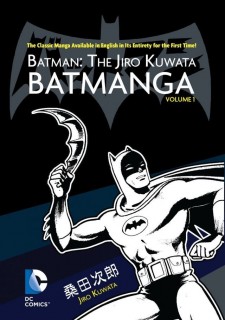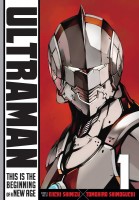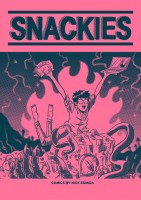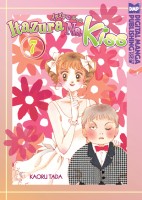My News and Reviews
Last week at Experiments in Manga I announced the winner of the superhero duo manga giveaway. As usual, the post also includes a list of manga, in this particular case a list of manga featuring superheros of one ilk or another. Last week I also posted my review of Rokudenashiko’s comic memoir What Is Obscenity?: The Story of a Good for Nothing Artist in Her Pussy which is a wonderfully engaging and important work. Rokudenashiko is one of the featured guests at the Toronto Comic Arts festival which is this upcoming weekend; I greatly admire her and her work, so I’m looking forward to having the opportunity to meet her in person.
Elsewhere online: Rokudenashiko was recently interviewed in preparation for her trip to Toronto. Massive Goods hints at an upcoming announcement regarding an English-language release of Gengoroh Tagame’s award-winning My Brother’s Husband, which I am super-excited about. And Ryan Holmberg wrote a about Katsumata Susumu’s Anti-Nuclear Manga for the Sainsbury Institute and, at the other end of the spectrum, about the Nuclear Literati: Nakashima Kiyoshi’s Furusato Goes to Hell for The Comics Journal.
Quick Takes
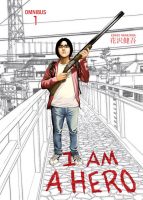 I Am a Hero, Omnibus 1 (equivalent to Volumes 1-2) by Kengo Hanazawa. By this point I’m fairly burned-out when it comes to zombies, but I had heard so many good things about the award-winning I Am a Hero that I had to give it a try. And, I must admit, the manga is one of the most interesting and best examples of the genre that I’ve come across in quite some time. For me what makes I Am a Hero stand out is the lead character, Hideo. After making his debut as a professional mangaka, he’s back to being an assistant when his career failed to take off. He has the tendency to talk to himself, hear voices, and hallucinate, so everything that he experiences has to be questioned. The zombie apocalypse doesn’t really come until the second half of the first I Am a Hero omnibus. Until that happens, most of the hints and clues of the impending disaster can be easily dismissed as part of Hideo’s delusions. When the apocalypse finally does happen the series suddenly becomes horrifyingly brutal and grotesque as the world descends into chaos. Hideo remains surprisingly calm in the face of it all, partially because he initially assumes that the end of the world is just another one of his hallucinations. By the end of the first omnibus there’s already an extraordinarily high body count (most the named characters are done for and even Hideo isn’t completely unscathed), so I am very curious to see where the series goes from here.
I Am a Hero, Omnibus 1 (equivalent to Volumes 1-2) by Kengo Hanazawa. By this point I’m fairly burned-out when it comes to zombies, but I had heard so many good things about the award-winning I Am a Hero that I had to give it a try. And, I must admit, the manga is one of the most interesting and best examples of the genre that I’ve come across in quite some time. For me what makes I Am a Hero stand out is the lead character, Hideo. After making his debut as a professional mangaka, he’s back to being an assistant when his career failed to take off. He has the tendency to talk to himself, hear voices, and hallucinate, so everything that he experiences has to be questioned. The zombie apocalypse doesn’t really come until the second half of the first I Am a Hero omnibus. Until that happens, most of the hints and clues of the impending disaster can be easily dismissed as part of Hideo’s delusions. When the apocalypse finally does happen the series suddenly becomes horrifyingly brutal and grotesque as the world descends into chaos. Hideo remains surprisingly calm in the face of it all, partially because he initially assumes that the end of the world is just another one of his hallucinations. By the end of the first omnibus there’s already an extraordinarily high body count (most the named characters are done for and even Hideo isn’t completely unscathed), so I am very curious to see where the series goes from here.
 Maga-Tsuki, Volume 1 by Hoshino Taguchi. Apparently the initial inspiration behind Maga-Tsuki was originally going to be worked into a shōnen battle manga, but in the end it turned into a harem-ish romantic comedy. Personally, in this case I probably would have been more interested in the action-oriented series, but Maga-Tsuki does offer some variations on the usual tropes that are amusing. It is, however, very trope-heavy and contains the expected levels of fanservice for this type of story. When he accidentally breaks the sacred mirror protected by his family’s shrine, Yasuke finds himself cursed by the goddess sealed within it. In order to lift the curse he must make Orihime, a goddess of calamity and misfortune, happy, which proves to be something of a challenge. In the meantime, his soul has been separated from his body and he must maintain constant physical contact with Orihime or else he will die. A kiss from Orihime will conveniently revive him, though. This obviously results in all sorts of complications and misunderstandings, especially when it comes to trying to confess his feelings to the girl that he likes. I like that Maga-Tsuki makes use of Japanese mythology, otherwise I’m not sure that it would have managed to hold my attention. However, I do have a hard time seeing the sweetly cute and seemingly innocent Orihime as an ancient, all-knowing goddess even if her divine powers are suitably impressive.
Maga-Tsuki, Volume 1 by Hoshino Taguchi. Apparently the initial inspiration behind Maga-Tsuki was originally going to be worked into a shōnen battle manga, but in the end it turned into a harem-ish romantic comedy. Personally, in this case I probably would have been more interested in the action-oriented series, but Maga-Tsuki does offer some variations on the usual tropes that are amusing. It is, however, very trope-heavy and contains the expected levels of fanservice for this type of story. When he accidentally breaks the sacred mirror protected by his family’s shrine, Yasuke finds himself cursed by the goddess sealed within it. In order to lift the curse he must make Orihime, a goddess of calamity and misfortune, happy, which proves to be something of a challenge. In the meantime, his soul has been separated from his body and he must maintain constant physical contact with Orihime or else he will die. A kiss from Orihime will conveniently revive him, though. This obviously results in all sorts of complications and misunderstandings, especially when it comes to trying to confess his feelings to the girl that he likes. I like that Maga-Tsuki makes use of Japanese mythology, otherwise I’m not sure that it would have managed to hold my attention. However, I do have a hard time seeing the sweetly cute and seemingly innocent Orihime as an ancient, all-knowing goddess even if her divine powers are suitably impressive.
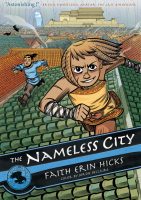 The Nameless City, Volume 1 by Faith Erin Hicks with colors by Jordie Bellaire. In general I tend to be fond of Hicks’ work, but I’ve been especially anticipating the debut of The Nameless City trilogy having followed its development and progress online. The titular Nameless City is a city that has been conquered and re-conquered countless times. Situated in a geographically advantageous location which allows the ruling kingdom immense control over the area’s economics and trade it makes a sought-after target. The city is currently under the domain of the Dao and has been for a few decades, but it’s likely only a matter of time before there’s another invasion or the residents rise up in revolt. Inspired in part by Chinese history, The Nameless City is about an unlikely friendship that develops over the backdrop of warfare, clashing cultures, and political intrigue. Kaidu is one of the Dao, sent to the Nameless City to participate in military education and training (though he’d much rather be reading than fighting), while Rat is one of the city’s many orphans whose parents were killed by the Dao. As Kaidu gets to know Rat he gets to know the city, and he learns more about his own people in the process, too. As for Rat, she initially hates Kaidu simply because he is Dao, but that slowly changes as she realizes that not all Dao are the same. I’m really enjoying seeing their relationship develop and look forward to the next volume, The Stone Heart, a great deal.
The Nameless City, Volume 1 by Faith Erin Hicks with colors by Jordie Bellaire. In general I tend to be fond of Hicks’ work, but I’ve been especially anticipating the debut of The Nameless City trilogy having followed its development and progress online. The titular Nameless City is a city that has been conquered and re-conquered countless times. Situated in a geographically advantageous location which allows the ruling kingdom immense control over the area’s economics and trade it makes a sought-after target. The city is currently under the domain of the Dao and has been for a few decades, but it’s likely only a matter of time before there’s another invasion or the residents rise up in revolt. Inspired in part by Chinese history, The Nameless City is about an unlikely friendship that develops over the backdrop of warfare, clashing cultures, and political intrigue. Kaidu is one of the Dao, sent to the Nameless City to participate in military education and training (though he’d much rather be reading than fighting), while Rat is one of the city’s many orphans whose parents were killed by the Dao. As Kaidu gets to know Rat he gets to know the city, and he learns more about his own people in the process, too. As for Rat, she initially hates Kaidu simply because he is Dao, but that slowly changes as she realizes that not all Dao are the same. I’m really enjoying seeing their relationship develop and look forward to the next volume, The Stone Heart, a great deal.




